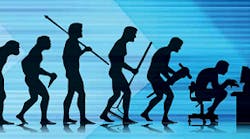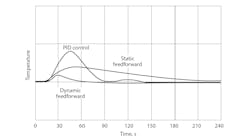Robots are the outgrowth of process control, and therefore, all control knowledge accumulated in automating regular industries also applies to robots. The only difference is their controller is an artificial intelligence (AI) "brain” that simultaneously receives a large number of measurements and, in response, manipulates a large number of variables (motors, magnets, springs, etc.). It does this in a manner that's identical to industrial controllers when they throttle control valves or position moving parts. So, robots are multivariable controllers, a natural outgrowth of automation.
Automation opened a new age for mankind. First, it was just a tool that served our comfort as it substituted for our muscles and, later, for the routine functions of our brains. However, we’re starting to realize that we've "created" something that's much more than a tool to serve our comfort.
When we designed the first gadgets that made industry safer and more efficient, we didn’t know where this would lead. Next, we designed "smart" instruments, so they would self-diagnose—in other words check themselves and report if there was something wrong with them. This road eventually led to robots, and today, we're beginning to comprehend that there's a possibility that these human creations will become more than our mechanical slaves (Figure 1).
Figure 1: The evolution of automation led to robots, and today, we're beginning to realize that there's a possibility for these human creations to become more than our mechanical slaves.
At first, we believed that robots were good because they can do things that are boring or they can do things more accurately and faster. Later, we learned they can go to places that are inhospitable for us, such as Mars, war zones or the bottom of the ocean.
Now, we're also beginning to realize that AI can change our lifestyles. Today, the average human spends seven hours a day staring at some screen and just 16 minutes exercising. Today, when our AI-brained robots can not only build cars, but can also drive them, we begin to ask, will this creation of ours make its creator unnecessary? And by this, I don’t only mean unemployed.
Figure 2: As we become keyboard clickers and intellectual garbage consumers, do we know where it will lead us, or the generation that follows?
Of course, we have only just started on this slippery slope, but we have started. We’re beginning to become keyboard clickers and intellectual garbage consumers, are we not? (Figure 2) Do we know where this road will lead us or the generations that follow us? Yet, we do know that AI robots can not only spread valuable information, but also falsehoods.For decades, people have predicted that machines would make workers obsolete and cause unemployment. But as of today, to my knowledge, not a single human has been replaced by a humanoid robot, while many new jobs have been created by designing such applications.
Robots can be autonomous or semi-autonomous, and can serve many applications besides industrial ones. These include but aren't at all limited to medical, military, miniature, or even microscopic or humanoid applications. Semi-autonomöus designs are able to perform such tasks as finding power sources or, in military applications, independently choosing targets. Autonomous robots are expected to proliferate in the coming decades, with home robotics and the autonomous car applications being most common.
Humanoid robots are not necessarily designed to accomplish a task, but to just mimic the abilities of human beings. They're designed to move as closely as possible to the ways humans move. For example, they have rib cages, backbones and rotating joints, and they can even hit a badminton birdy. Humanoid robots can also play a role in car crash tests, where they provide a more realistic depiction of what actually happens to humans when they undergo such trauma.
Figure 3: Killer machines can choose targets on their own and, depending on their software, might not be able to distinguish civilian from military targets, or enemies from friendly forces.
In addition, today some 40 nations are developing robot soldiers (Figure 3). Some of these are machines that no longer need human direction because they can think for themselves. Such killer machines can choose targets on their own, and depending on their software, might not be able to distinguish civilian from military targets or enemy soldiers from friendly forces.We know the global AI arms race has already started. Some $120 billion has been spent in 10 years on developing and improving these killing machines, which have no moral judgment, no consciousness, nor such feelings as mercy. Nations are developing these machines in secret, and some would even give them mini-nuclear weapons and send them into space.
These developments are totally out of control, and international regulations must be established and enforced both in the fields of nuclear and in the field of AI-based weapons development. It's up to us to direct the development of AI in the right direction, which is to develop AI as a tool that will serve us to make life better, easier and happier. In other words, we must stay in control to make sure that AI will do only what it should and not what it can because it can divert human evolution. We must always remember that AI has no conscience, no moral or ethical values, that its brain is only an algorithm, and that algorithm can not only drive cars, but potentially attack democracy or even civilization.
We process control engineers know there can’t be a control loop without a controller, and that there's nothing more dangerous than an out-of-control control loop. For example, we must never allow the use of automobiles without human overrides because no matter how sophisticated AI algorithms become, we must always stay in control. Obviously, we must stay in control not only of machines, but of AI development processes. This means our controller (mankind) needs a manipulated variable (like a control valve) to keep the loop on target.
This manipulation is needed both to give this development the right direction, but also to prevent it from causing unemployment. So, what can we manipulate to reach this goal? Obviously, this manipulated variable must be the education of the workforce. Naturally, to convert our workforce from an industrial one to one that is fit for the digital age of the 21st century, we must make higher education accessible to all, and tax digital gadgets such as mobile phones to pay for it.






